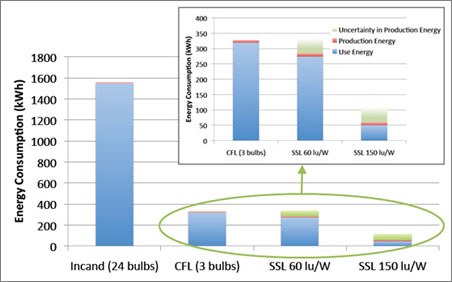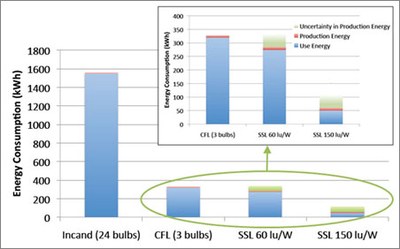Cree Study Shows LED Lighting is Best Bet for Energy Efficiency
A new report on the life-cycle energy usage of energy-efficient lighting by Cree, Inc. shows that LED lighting products are now more efficient than traditional lighting products when compared across the high-volume applications of recessed downlighting and display spotlighting. Evaluating light fixtures and applications, the white paper’s energy comparisons demonstrate that LEDs offer clear advantages in terms of energy costs and environmental impact over traditional lighting such as incandescent, halogen and compact fluorescent bulbs.
“As we face increasing environmental and cost concerns about our traditional energy sources, energy-efficient lighting continues to be a hot topic in today’s discussions on climate change and sustainability,” explained Monica Hansen, research scientist, Cree. “With 22 percent of the electricity used in the U.S. consumed by lighting, energy-efficient LED lighting offers a tremendous opportunity for savings.”
The conclusion of the Cree “Energy-Efficient Lifecycle White Paper” is that LEDs are the most efficient light source available today for the examined applications. They are also a greener solution when compared to compact fluorescent bulbs (CFLs), as LEDs contain no toxic mercury. Citing recent studies conducted by Carnegie Mellon University and OSRAM Opto Semiconductors, Cree’s paper assesses state-of-the-art LED fixtures to demonstrate the inherent improvements in lighting efficiency available when using fixtures designed specifically to use LEDs. Additionally, the study examines two of today’s dominant lighting applications, downlighting and spotlighting, in order to accurately determine the energy impacts of using LEDs.
"An applications-based analysis of life-cycle energy use is more reflective of what users will experience," said Steven DenBaars, professor and co-director of the Solid State Lighting & Energy Center, University of California Santa Barbara and Cree technical advisor. "LED lighting is clearly the most efficient and the greenest light source for the applications discussed in this paper."
Highlights of the study include:
• The usage phase of energy-efficient lighting dominates the lifetime energy consumption – with 96 to 98 percent of energy used to generate light and less than four percent due to the manufacturing process.
• To meaningfully compare lighting efficiencies, lighting applications must be included, not just light sources. Today LEDs are the most efficient choice for the high-volume lighting applications of residential and commercial recessed downlights and narrow-beam spotlights.
• LED performance has improved swiftly, leading to rapidly rising efficacies and is projected to continue to outperform other lighting technologies by ever-widening margins.
To view the entire study, please visit http://www.cree.com/lifecycle.
About Cree:
Cree is leading the LED lighting revolution and setting the stage to obsolete the incandescent light bulb through the use of energy-efficient, environmentally friendly LED lighting. Cree is a market-leading innovator of lighting-class LEDs, LED lighting solutions, and semiconductor solutions for backlighting, wireless and power applications.
Cree’s product families include recessed LED down lights, blue and green LED chips, high-brightness LEDs, lighting-class power LEDs, power-switching devices and radio-frequency/wireless devices. Cree solutions are driving improvements in applications such as general illumination, electronic signs and signals, variable-speed motors, and wireless communications.
For additional product and company information, please refer to www.CreeLEDlighting.com.


